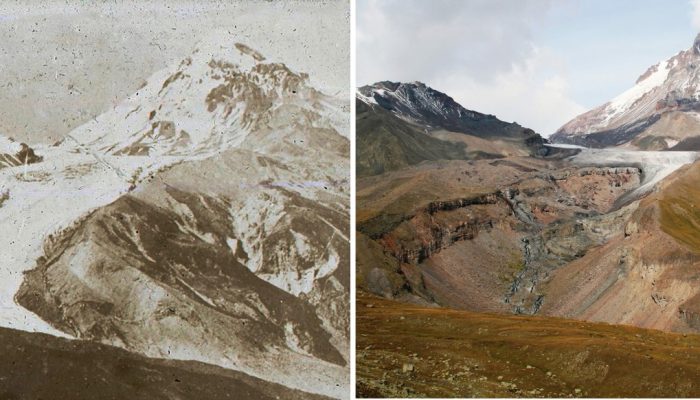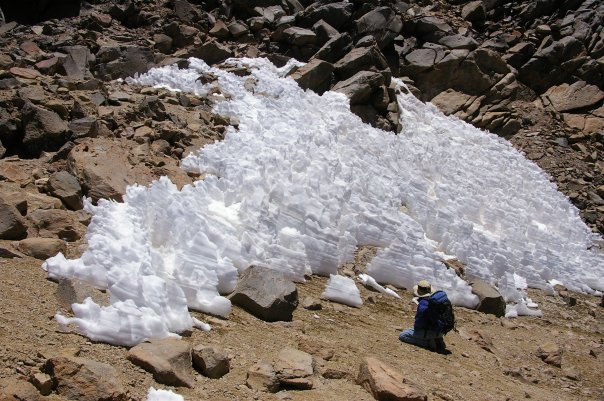
In 1896 British lawyer, mountaineer and author Douglas Freshfield climbed an obscure mountain in the Caucasus called Kasbek and in his book detailing his adventures he described the mountain:
“From this point the view of Kasbek is superb: its whole north-eastern face is a sheet of snow and ice, broken by the steepness of the slope into magnificent towers, and seamed by enormous blue chasms.”
D Freshfield (1986) The Exploration of the Caucasus, page 93
A photo of the mountain taken at the same time highlights the Gergeti glacier (called at the time the Ortsveri glacier) running down the centre of the image. In 2015 Levan Tielidze took another photo of the same view which highlighted a shocking change.
The photo above echoes photos taken of mountain glaciers from across the globe over the last 100 years. All these photos, when compared with their older counterparts, show the comprehensive retreat of mountain glaciers in every country. The retreat of mountain glaciers was called a ‘canary in the coal mine’ along with other indicators of global climate change. But new data presented this month at the European Geosciences Union General Assembly, shows us that that canary is now past saving.
Ben Marzeion, professor of Geography and Climate Science at the University of Bremen, has found that mountain glacier retreat (and eventual disappearance) is now inevitable. In a session relating to the Paris agreements (where 195 countries from around the globe agreed to work towards limiting global temperature change to two degrees) Marzeion presented evidence that indicates that even if that ambitious target were achieved, 60% of current mountain glaciers will still melt away. In fact the impacts of climate change are more severe than even this number suggests. Prof Marzeion explains:
‘Even if climate warming were to stop today – which is physically impossible – about one third of the glacial ice in the world would still melt in the long term.’
This is because the ice in the mountain glaciers responds to climate change with a time delay. Mountain ice is not sustainable and more than half of the ice in a mountain glacier is responding to temperature change that has already happened. The ice of the mountain glaciers has been melting for decades and once that process begins, it is very difficult to stop. Smaller glaciers and those at lower altitudes are at greater risk of complete loss, but Professor Marzeion says that any glacier where the summer snowline rises above the mountain peak will not survive. This has wider implications for water use in mountainous areas.
‘Saving the glaciers is an illusion in many mountain ranges,’ says Marzeion. ‘We will have to adapt to the consequences of glacier melt. This will affect the coastal regions of the world, but also populations in the mountainous regions, who will have one fewer source of water at their disposal in summer.’
Although the question of global temperature change is still one that we have to solve, it seems that our desire to take responsibility for our actions comes too late for those ‘magnificent towers’ and ‘blue chasms’ that Douglas Freshfield described over 100 years ago.
By Hazel Gibson, EGU General Assembly Press Assistant and Plymouth University PhD student.
Hazel is a science communicator and PhD student researching the public understanding of the geological subsurface at Plymouth University using a blend of cognitive psychology and geology, and was one of our Press Assistants during the week of the 2016 General Assembly.





